|
|
|
Sort Order |
|
|
|
Items / Page
|
|
|
|
|
|
|
| Srl | Item |
| 1 |
ID:
128563
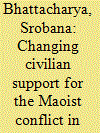

|
|
|
|
|
| Publication |
2013.
|
| Summary/Abstract |
Prolonged domestic political conflicts change over time. The Maoist conflict in India which began in the late 1960s is one such conflict. Over time, the 'old' Maoist conflict has become a 'new' Maoist conflict. Important changes have occurred both in the macro and micro processes of the conflict. Some of these changes include the strategic relocation of the Maoist bases, a shift in the class character of the conflict, the nature of civilian support, and the rebels' methods of operation. While in the 1960s, the conflict was involved in land redistribution with the aim of annihilating class enemies, the recent conflict focuses on caste identities. In addition, it is intrinsically linked with territorial control and local political competition. This has automatically led the Maoists to become involved with local criminal networks and also local business networks based. This involvement has led to financial resources for the conflict. Furthermore, it has forced the local population to become linked with the conflict. Studying these changes is important, especially for counterinsurgency policies.
|
|
|
|
|
|
|
|
|
|
|
|
|
|
|
|
| 2 |
ID:
128578
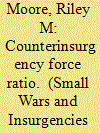

|
|
|
|
|
| Publication |
2013.
|
| Summary/Abstract |
As a consequence of intervention in Iraq and Afghanistan, force ratio for counterinsurgency (COIN) has come under increased scrutiny. Reduced to its essence, the issue is simply, 'How many troops does it take to get the job done?' This answer has been sought by the US military, academia, and think tanks. There have been numerous responses, culminating in several 'plug-and-play' equations for minimum force ratios in COIN operations. Due to the impossibility of determining precisely how many insurgent forces there are, it has become common to base force ratios on the population of the country. In the realm of policy, the question above is posed as, 'How many of our troops does it take to get the job done?
|
|
|
|
|
|
|
|
|
|
|
|
|
|
|
|
| 3 |
ID:
128574
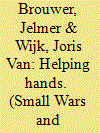

|
|
|
|
|
| Publication |
2013.
|
| Summary/Abstract |
This article analyses to what extent the Burmese KNU insurgency made use of external support from states, refugees, and diasporas. Based on extensive fieldwork it is concluded that support from neighbouring states and refugees has for years kept the Karen rebellion alive. Western countries perceived forms of resistance to the illegitimate Burmese regime as just and have therefore played a crucial role in the continuation of conflict in Karen State. It is important that policymakers and donors as well as executing organizations continue to reflect critically on the way they exercise their work.
|
|
|
|
|
|
|
|
|
|
|
|
|
|
|
|
| 4 |
ID:
128328
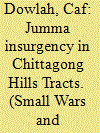

|
|
|
|
|
| Publication |
2013.
|
| Summary/Abstract |
Bangladesh, otherwise a homogeneous society, confronts a serious tribal insurgency in its southeastern Chittagong Hill Tracts region. Before signing a Peace Accord in 1997, the tribal groups, known as Jummas, who constitute 1% of the nation's population but occupy about 10% of its territory, fought insurgency battles for over two decades demanding recognition of their ethnic identities and autonomy of their region. The highly controversial Accord, however, still remains largely unimplemented, and often it evokes fears of secession. This article argues that a probable secession of the Chittagong Hill Tracts (CHT) may not be in the best interests of the Jummas or the people of Bangladesh; and a pragmatic resolution of the issue may lie with granting full functional autonomy to the Jummas in a constitutionally protected reservation area.
|
|
|
|
|
|
|
|
|
|
|
|
|
|
|
|
| 5 |
ID:
128551
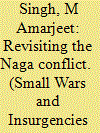

|
|
|
|
|
| Publication |
2013.
|
| Summary/Abstract |
Soon after India attained its independence from British colonial administration in 1947 the Nagas started waging an armed conflict against India to establish a sovereign independent state in Nagaland in the country's Northeast region. The conflict is today one of the world's longer running and little known armed conflicts. India's central government has tried unsuccessfully to tackle the problem through political reconciliation, use of force, and several development measures. Over the years, it has also undergone several changes in which the situation of conflict deepened whenever India's central government intervened. And yet, the road ahead also faces severe challenges because the demand for bringing the Nagas of India together into a single political entity will not go unchallenged from other ethnic groups. Moreover, a bitter leadership battle divides the Naga rebels and hence any future agreement is likely to be difficult due to factional politics as have happened in the past. Thus one way to satisfy the aspirations of different ethnic groups while protecting the boundaries of the existing states in India is to explore the option of cultural autonomy. This idea is not entirely new, but has lost significance over the years.
|
|
|
|
|
|
|
|
|
|
|
|
|
|
|
|
| 6 |
ID:
128584
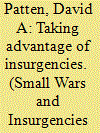

|
|
|
|
|
| Publication |
2013.
|
| Summary/Abstract |
Taking insurgency sponsorship as an instrument states have available for achieving foreign policy objectives, I consider how state-sponsors could best manipulate their support to maximize control of the proxy group. Building on research that models the state-sponsor-insurgent relationship using a principal-agent framework, I identify two key vulnerabilities to which the state-sponsor is exposed: adverse selection and agency slack. As an original contribution to the literature on state-sponsorship of insurgency, I articulate reasons why certain forms of support would be most conducive to overcoming these problems and illustrate how South Africa and Iran used those kinds of support to influence the behavior of their proxies, RENAMO and Hezbollah. Additionally, I consider how this principal-agent analysis of insurgency sponsorship also could apply when the principal is an international terrorist organization such as al Qaeda. Finally, I address the relevance of these ideas to two contemporary conflicts taking place in Syria and the Congo.
|
|
|
|
|
|
|
|
|
|
|
|
|
|
|
|
|
|
|
|
|